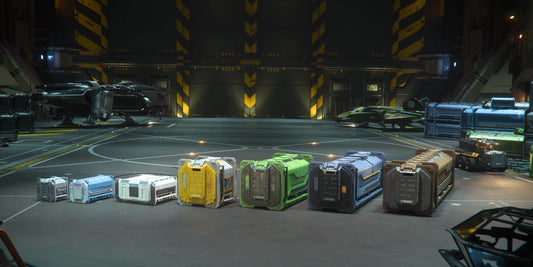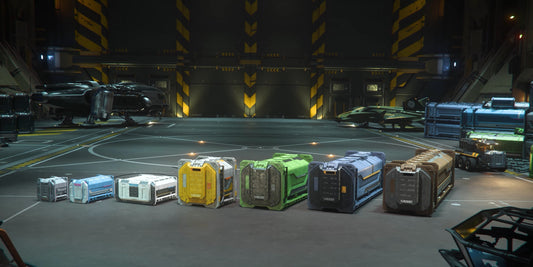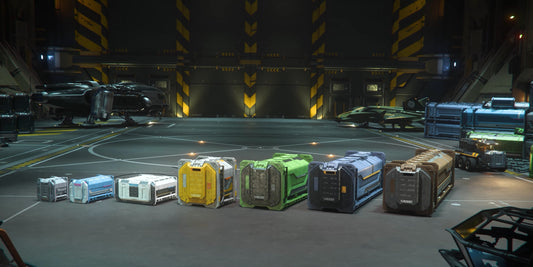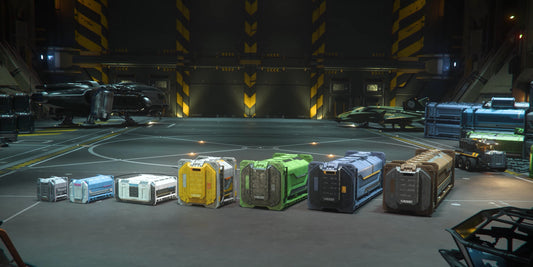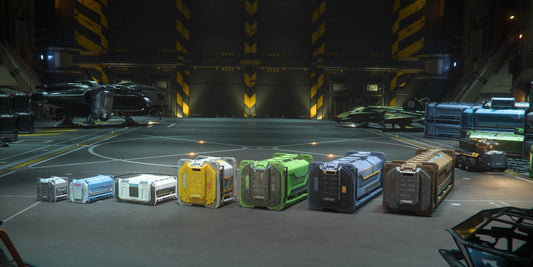Star Citizen Medical System Explained: Injuries, Death & Healing Guide
Since Alpha 3.15, Star Citizen introduced a new medical and vitality system, including segmented body damage, incapacitation states, new medical tools and medications, and medical facilities such as hospitals and clinics scattered throughout the universe. This set of mechanics significantly enriches the game's survival gameplay, where characters no longer just have a simple health bar but must contend with injuries to different body parts, the severity of injuries, and the effects of medications. This article will delve into the current system's operation, including character health status, damage and incapacitation determinations, the use of medical tools and medications, and how Blood Drug Levels (BDL) influence treatment efficacy.
Character Health and Limb Injury System
In Star Citizen, characters do not have a single health bar but instead use a segmented health and injury system based on body parts. The body is divided into six sections: head, torso (chest), left and right arms, and left and right legs. Each body part has its own individual status, and when a part is injured, it will affect the character’s abilities accordingly:
- Head injuries:
Blurry vision, reduced hearing, and in severe cases, dizziness or loss of consciousness.
- Torso injuries:
Reduced stamina, making the character more prone to heavy breathing. In severe cases, it may cause the character to collapse and lose mobility.
- Arm injuries:
Unsteady aim when using firearms, decreased accuracy, reduced melee damage. Severe arm injuries may prevent the character from holding weapons or objects.
- Leg injuries:
Reduced movement speed, limited ability to run and walk. Severe leg injuries may leave the character unable to stand or walk, forcing them to crawl.
- Overall health:
Any body part injury reduces the character's overall health. If the injuries are severe enough, the character will enter a disabled state (loss of mobility) and may die due to the extent of the injury.
It’s important to note that continuous damage will also reduce the overall health (HP). Injuries to different body parts will accumulate and affect the character’s survival. Therefore, protecting critical areas like the head and torso is essential, as fatal injuries to these areas often lead directly to death or a near-death state.
Injury Levels and Symptom Manifestation
After a character is injured, the severity of the injury determines the classification into three injury levels (also known as damage tiers), ranging from mild to severe: Light Injury (Tier 3), Moderate Injury (Tier 2), and Heavy Injury (Tier 1). The severity of the injury will result in varying symptoms, affecting the character's actions and determining the required level of medical treatment:
- Light Injury (Tier 3):
Slightly affects the functionality of the affected part. For example, a light arm injury will cause weapon shaking, reduced melee strength, a light leg injury will slightly decrease movement speed, a light torso injury will reduce the stamina limit and cause shortness of breath, and a light head injury will result in mild visual blurring and hearing loss. In the light injury state, the character can still move normally and does not require a medical bed to stabilize the injury. However, light injuries will reduce the character's maximum health, meaning total HP cannot be restored to its full value.
- Moderate Injury (Tier 2):
Symptoms worsen, and the character will clearly feel limited in movement and in pain. Injuries to the limbs may cause a limp (causing the character to walk unevenly) and painful breathing. Moderate injuries to the head or torso severely affect perception and balance. It is important to note that moderate injuries to the head or chest must be stabilized on a medical bed as soon as possible, or the injury may worsen and pose a life-threatening risk.
- Heavy Injury (Tier 1):
This is the most severe type of injury, with symptoms worsening further and potentially leading to the complete loss of function in the affected part. A heavy leg injury will render the character unable to stand or crouch, and they can only crawl. A heavy arm injury will completely prevent the character from using their hands to carry items or weapons. A heavy head or torso injury will quickly put the character into a life-threatening incapacitated state, requiring urgent stabilization on a medical bed, or they will die from the injuries. Heavy injuries often indicate the character is on the brink of death.
These three injury levels not only affect immediate combat performance but also determine the level of medical intervention required (discussed in detail below). Additionally, overuse of an injured limb may worsen the injury. For example, running on a lightly injured leg may worsen it into a moderate injury. Therefore, when a part of the body is injured, it is best to avoid putting stress on that part or engaging in vigorous activity to prevent the injury from worsening.
Incapacitation State and Death Mechanism
When a character suffers severe damage, they enter an incapacitation (near-death) state. In this state, the character will fall to the ground, unable to move or interact, with their vision flickering on and off. A life countdown will appear on the HUD, showing the remaining time before death. If the character suffers a fatal injury (such as a headshot or a violent explosion), they may die instantly, skipping the incapacitation phase.
Once in the incapacitation state, the character does not die immediately; instead, there is a brief period of waiting for rescue. Timely medical intervention is critical: if someone uses a medical tool to inject Hemozal (a medical revival drug) before the countdown ends, the character can be revived and their survival time extended. Hemozal is typically injected via a MedPen or a medical gun, restoring some health and stopping the bleeding, allowing the character to exit the incapacitation state. However, if no help arrives before the countdown reaches zero, the character will die from their injuries and will be respawned at the nearest spawn point (usually the last registered hospital or medical station).
Calling for Help and Rescue: When playing solo, if the character falls into an incapacitated state, they can press the "M" key (default) to send an emergency medical distress signal (rescue Beacon) to request nearby players for assistance. If someone accepts the task and arrives at the location, they can use a medical gun or MedPen to inject Hemozal and revive the character, then escort them to a medical facility. Once the injured character is brought to the hospital’s emergency entrance, the rescuer will receive a preset task reward (default is 15,000 aUEC). It's important to note that if you die, any items you were carrying will remain at the site of your body, so it’s best to seek medical help while incapacitated to avoid losing your items due to death.
Respawning and Reviving: When a character ultimately dies, the game uses a medical respawn system to allow players to come back to life. Each character can set their respawn point at a large medical facility (Tier 1 hospital or Tier 2 clinic with a medical bed). Upon death, the character will respawn as a clone at the chosen respawn point's medical bed, continuing the game from there. If no respawn point has been set, the system defaults to respawning the player at a hospital in the city where they initially started (e.g., New Babbage or Orison). Players must interact with the medical bed to update their respawn point, and once bound, that station will serve as their revival point in the event of death. Currently, players can respawn indefinitely, but according to the developers’ initial “Death of a Spaceman” design, future updates may introduce lasting consequences for repeated respawns, including permanent death (i.e., the character must be fully recreated). However, in the current version, this penalty mechanism is not yet implemented. After death, players only need to pay a fee to respawn without any permanent ability degradation.
Use of Medical Tools and Medications
When players are in the wilderness or far from hospitals, they need to rely on portable medical tools and medications for self-treatment or rescuing others. Currently, the game provides several types of individual medical equipment:
- MedPen:
A single-use injection syringe. The Hemozal MedPen is the most basic first aid item, directly restoring health and stopping bleeding, quickly bringing a downed player out of the incapacitated state. Other types of pens do not restore health but are used to alleviate specific injury symptoms (see the table below). MedPens are small, easy to carry, and are consumed after one use.
- Multi-tool (Medical Module):
The multi-tool from Greycat Industries can be equipped with the LifeGuard medical module. This modified multi-tool can be reused and functions similarly to the basic medical gun, capable of injecting a limited variety of medications. In general, the multi-tool is mainly used to inject Hemozal for treatment, which can restore health but cannot cure specific disabilities. It is suitable for emergency rescues but is less flexible than the medical gun due to its limited drug types and dosage.
- Medical Gun (CureLife Medical Tool):
Commonly known as the "MedGun," this is a professional medical device manufactured by CureLife. The MedGun has two modes: basic and advanced. In basic mode, it functions similarly to the multi-tool but with fewer features. In advanced mode, the MedGun can diagnose the patient’s condition in detail and allow the user to adjust the injection of different medications and dosages. With the advanced mode, the MedGun not only restores health but also provides precise treatment for specific injuries. The MedGun is reusable and can carry multiple doses of medication, making it a great tool for medical rescue players.
Below is a summary of the five types of medical medications and their main effects:
Usage Tips: When medical terminals are not available, the injection pens offer a simple means of self-help or rescuing others. However, since the pens do not display patient vitals, it is recommended to use a medical pen when treating yourself (since you can check your condition through the helmet HUD) and a medical gun or multi-tool for others to assess the specific injury and treat accordingly. Compared to the pens, medical guns and medical beds offer longer-lasting effects. The same dose of medication will have the longest-lasting effect when injected through a medical bed, followed by the medical gun (ParaMed device) and multi-tool, while the effect from the medication pens is the shortest and requires more frequent re-administration.
It's important to note that medical tools are not unlimited. If a patient's injury level exceeds the capabilities of the available medical tools (for example, trying to heal a severe injury with a basic medical gun), the most it can do is temporarily stabilize the injury, and the injury will still need to be treated at a higher-level medical facility.
Blood Drug Level (BDL) and Overdose State
Blood Drug Level (BDL) is an indicator that measures the amount of drugs in the player's system. Whenever the player uses any type of medical drug (except Resurgera) or consumes alcohol, the BDL value increases. Players can view the real-time BDL percentage through the HUD on their helmet or by scanning the target with a medical gun.
BDL has significant effects on the character’s condition. Once the BDL reaches a certain threshold (around 50% or more), the player will start experiencing overdose symptoms. Early symptoms of overdose include slowed movement, staggering while walking, blurry vision, difficulty aiming weapons, and even sluggish vehicle controls. As BDL continues to rise, the symptoms become more severe: when the concentration reaches dangerous levels (near 100%), the character enters an overdose collapse state—falling to the ground, unable to move, with periodic blackouts in vision, and continuous health damage. If not addressed in time, the character may fall into incapacity or even die due to the compounded overdose damage.
Handling Overdose:The only antidote for a high BDL is the Resurgera antidote (carried in the DetoxPen). Administering Resurgera quickly reduces the BDL and alleviates overdose symptoms, pulling the character out of the overdose state. However, Resurgera can only treat patients who have not fully passed out (i.e., are not incapacitated). If the character is already incapacitated due to overdose, Hemozal must first be administered to revive them, followed by an attempt to reduce the BDL to prevent further overdose.
Fortunately, BDL naturally decays over time. If the player survives the overdose long enough and does not continue injecting additional drugs, the BDL value will gradually decrease. Once it falls below a safe threshold, the character will recover from the overdose state. In emergency situations, players can also choose to wait for the drug effects to dissipate. However, it is important not to rush and repeatedly inject more drugs.
Overall, the BDL mechanism requires players to be cautious with medical drug usage, "taking only what is necessary." To avoid overdose, refrain from repeatedly using multiple drug pens in a short period of time. For example, after injecting a painkiller, do not immediately administer a stimulant—monitor your condition and use the detox pen to lower the BDL before continuing treatment. Using the advanced mode of the medical gun allows precise control over drug doses, minimizing the BDL accumulation, which is a crucial skill for medical players in a team.
Medical Facilities and Treatment Methods
Medical facilities in the game are categorized into three levels based on their healing abilities:
- Tier 3:
The lowest level medical stations, capable of fully healing light injuries. Examples include small medical ships (such as the Cutlass Red’s medical bed) and small medical rooms in outposts. These facilities cannot cure moderate or severe injuries but can provide emergency stabilization (such as stopping bleeding and maintaining vital signs), buying time for transport to more advanced hospitals. These small medical beds can also serve as temporary respawn points (if the player lies in the bed to bind it first).
- Tier 2:
Mid-level medical stations, capable of treating moderate injuries and lower. Examples include medical clinics on space stations and medical rooms on large exploration or luxury ships (such as the Carrack’s medical room or the 890 Jump’s clinic). Tier 2 facilities can fully heal light and moderate injuries. For severe injuries, they can stabilize the condition but cannot completely cure them. Tier 2 medical beds can also serve as respawn points.
- Tier 1:
The highest-level medical centers, capable of healing injuries of any severity, including severe injuries. Currently, Tier 1 medical centers are primarily located in major city hospitals (such as New Babich General Hospital or Orison’s Intensive Care Center), and will soon include specialized hospital ships (like Apollo Medical Ship’s advanced beds). In Tier 1 hospitals, players can receive full-body treatment, restoring severe injuries to full health. Additionally, these hospitals offer services like medical supplies and life insurance. Any Tier 1 medical bed can be used to set a respawn point, allowing players to respawn there after death.
When players enter a medical bed, if the facility’s level is sufficient to treat all their injuries, the system will offer an interface to choose treatment options for full recovery. If the player is unconscious (in a disabled state) and placed in a medical bed, the bed will automatically perform the best emergency treatment based on the condition to revive the player and stabilize their injuries. If the medical bed’s level is insufficient to fully treat the injuries (for example, using the Cutlass Red's Tier 3 bed for severe leg injuries), the bed will still try to stabilize the player and maintain vital signs, but they will need to be transferred to a higher-level facility for full healing. Fortunately, clinics on major space stations (Tier 2) and city hospitals (Tier 1) are widespread, meaning severely injured players can often receive further treatment if they can survive long enough to reach these areas.
Lastly, it’s worth noting that space station hangars or large medical ships typically have clearly marked emergency elevators for quick access to medical areas. Moving a disabled patient to these elevators will instantly transport them to the medical room above, significantly reducing rescue time. Utilizing these emergency elevators can provide vital treatment opportunities for severely injured players.
Through these mechanisms, Star Citizen has created a highly realistic future medical system. From battlefield first aid to hospital revival, every step requires players to make careful decisions: should you use an injection to keep going or wait for help? Should you treat your wounds yourself or call for assistance? With future updates, it’s expected that medical gameplay will continue to expand, potentially introducing permanent death and more medical equipment/skills, making roles like doctors and team rescue more important. In the current version, understanding and using the medical and health systems can significantly increase your chances of survival and provide crucial help to others. So, whether you're adventuring solo in space or with a team, remember to carry medical supplies, familiarize yourself with the effects of various medicines, and keep an eye on your blood drug level—these preparations and knowledge can determine whether you survive or perish in the vastness of space.

